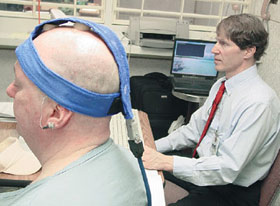 |
 |
 |
 Technology News | March 2005 Technology News | March 2005  
Man Executed Protesting His Innocence Underwent 'Brain Fingerprinting'
 Reuters Reuters


Larry Farwell, a Harvard-trained neuroscientist who works out of a small office in the Washington Technology Center on the University of Washington campus, hopes to use the case of Oklahoma death-row inmate Jimmy Ray Slaughter to convince law enforcement officials and the courts that the technique is scientifically sound and accurate. |
Mcalester, Oklahoma - An Oklahoma man who tried to prove his innocence through a little-known procedure called "brain fingerprinting" was executed by lethal injection Tuesday for the 1991 murder of a woman and her daughter.

Jimmy Ray Slaughter, 57, insisted he was not guilty even as the mix of lethal chemicals was injected into his arms at the Oklahoma State Penitentiary in McAlester.

"I've been accused of murder and it's not true. It was a lie from the beginning," he said while strapped to a gurney in the Oklahoma death chamber. "You people will know it's true some day. May god have mercy on your souls."

Slaughter sighed heavily as the chemicals flowed into his body and his face lost all color. He was pronounced dead in the first execution this year in Oklahoma.

Slaughter was condemned for the July 2, 1991, murders of his girlfriend Melody Wuertz, 29, and their 11-month-old daughter, Jessica, whom he killed in a fit of anger when Wuertz filed a paternity suit against him, prosecutors said.

Slaughter tried to get his conviction overturned by submitting to a "brain fingerprinting" test by Seattle-based neuroscientist Larry Farwell.

In the procedure, which the Harvard-educated Farwell says is accurate but has yet to gain much legal acceptance, the suspect is fitted with a headband-like sensor device, then shown photographs and other evidence from the crime scene.

Seeing something familiar is said to trigger brain waves of recognition, which the sensor detects and flashes on a computer screen.

Farwell told the Oklahoma Pardon and Parole Board in February that test results indicated Slaughter had not committed the crime, but the board members refused to grant him clemency. His fate was sealed when U.S. Supreme Court rejected his appeal Tuesday.

Slaughter's three daughters from an earlier marriage witnessed the execution and wept as they watched their father die. He raised his head before the chemicals took hold and tried to comfort them, saying, "It's OK, it's OK, I love you."

Slaughter was the 76th person executed in Oklahoma since the state resumed capital punishment in 1991, 15 years after the U.S. Supreme Court lifted a national death penalty ban.

For his final meal, he requested fried chicken, mashed potatoes, cole slaw, biscuits, apple pie and cherry limeade. | 
 | |
 |



